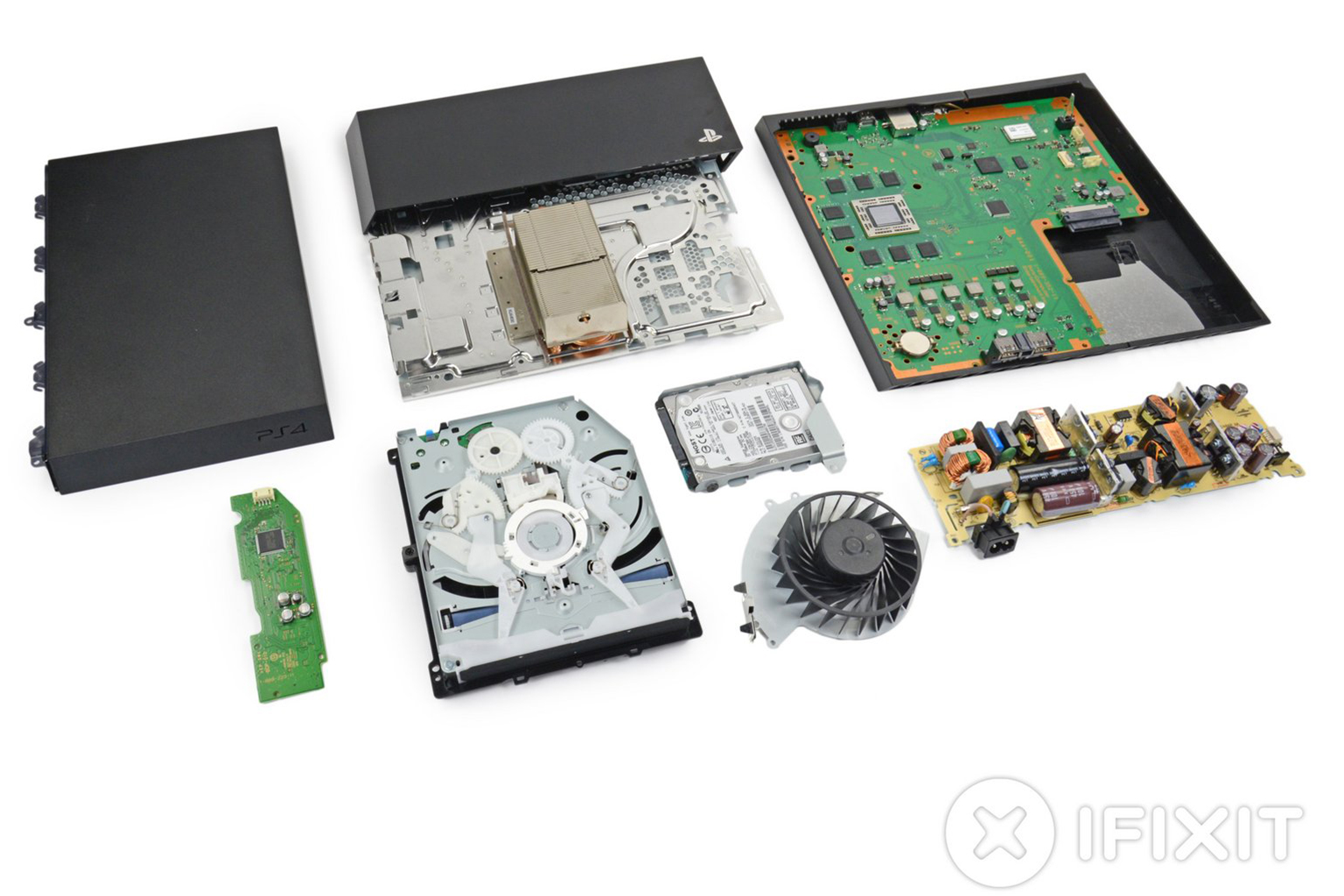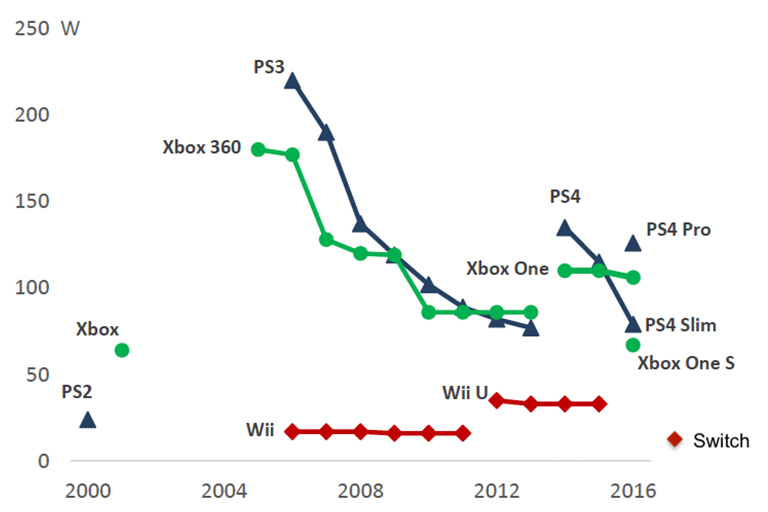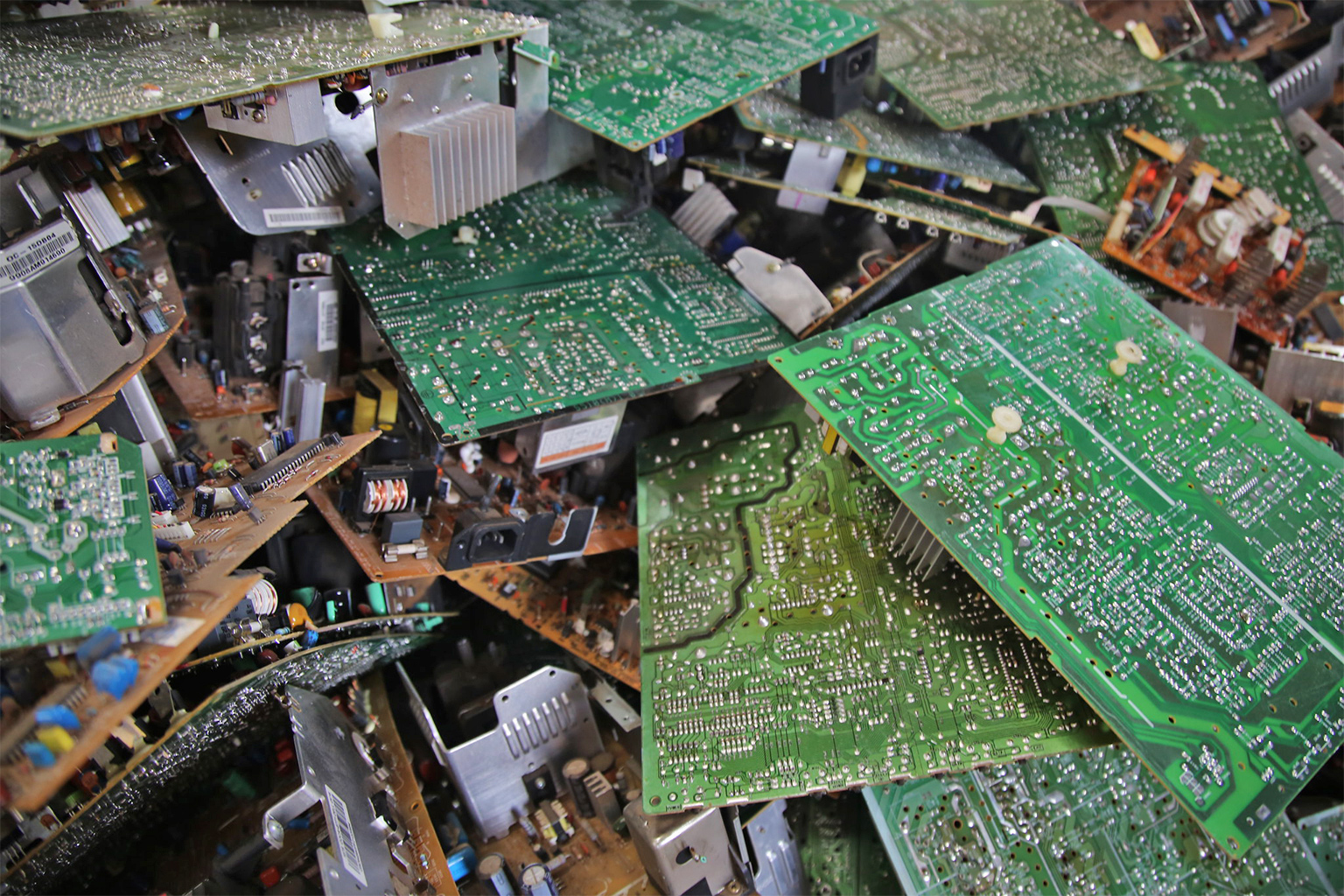- Like other consumer electronics, game consoles require complex supply chains that rely on the mining of metals and rare-earth elements, the production of new plastics, and highly specialized manufacturing processes — linking the industry to oversized carbon emissions.
- The latest generation of consoles use around 200 watts of electricity, placing them at the upper end of household appliances. U.S. gaming consoles churn through roughly 34 terawatt-hours of electricity per year, associated with an estimated 24 million metric tons of carbon emissions.
- While the newer devices have built-in energy efficiencies, their added features and performance upgrades often eat up those savings. The rapid replacement of one generation with the next has also led to a path of designed obsolescence, which has resulted in complex waste and disposal issues.
- Awareness of gaming’s oversized environmental impact has grown, and major manufacturers have promised to reduce the environmental footprint of their consoles over the next two decades, but consumer demand for longer console life spans and greater repairability will be key.
It began with Pong, an early home video game involving two pixelated paddles and a ball that introduced millions to the thrill of gaming. What started as an arcade game in 1972 entered homes during the 1975 Christmas season. Since then, electronic video gaming has blossomed into a graphically stimulating multibillion-dollar-a-year industry, entertaining more than 3 billion gamers globally.
But with explosive popularity has come problems. Like other electronics, gaming consoles are linked to a range of environmental threats, from the metals and plastics required to manufacture them, to the fossil fuel-derived electricity that powers them, to the challenges of recycling the devices after the rapidly deployed next generation displaces them.
Although these problems aren’t unique to consoles, the meteoric growth and sheer scale of the industry make it an obvious target for environmentally conscious improvements. With its engaged and discerning consumer base, the gaming industry could be primed for an eco-revolution.
Gaming consoles sourced in mining and drilling
Like other consumer electronics, game console components are sourced via complex global supply chains that rely upon the mining of critical elements (including metals and rare-earth elements) and the production of new plastics, with parts assembled via highly specialized manufacturing processes — linking the gaming industry to oversized carbon emissions and the devastating environmental and socioeconomic impacts of mining and petroleum extraction.
A new console’s ingredient list is stunningly long. It includes gold, copper, lead, nickel, zinc, lithium, cobalt and cadmium — the mining and purification of which are associated with huge energy and water usage, as well as environmental harm. Extracting and processing ores often releases large quantities of hazardous chemicals, such as arsenic or mercury, into surrounding communities and ecosystems. Also, much mining is done in tropical developing nations, where poorly regulated extraction and processing cause deforestation and pollution.

But it’s not all bad news: “I think that there’s a lot of environmental awareness about the need to replace those materials,” said researcher Claire Barlow at the University of Cambridge’s Department of Engineering. Although progress in that direction is being made, both in terms of engineering and environmental policy, “the downside [is] that the replacements tend not to be so efficient.”
Some raw materials, such as tungsten and gold, are predominantly mined in regions convulsed by civil unrest and inequality, and have been linked to human rights abuses. These so-called conflict minerals have attracted international attention, and the largest console manufacturers have taken steps to track, report and reduce the inclusion of conflict-linked metals in their electronics.
However, other elements such as cobalt are not classified as conflict minerals, so are subject to less stringent monitoring and reporting standards, yet are also commonly mined in dangerous and toxic environments, sometimes by children.
Once extracted, many raw materials go through lengthy, complex refining and manufacturing processes, finally culminating in the production of microchips in highly specialized ultra-clean rooms — all requiring massive amounts of energy.
“Whenever you’re talking about CPUs and GPUs, you’re talking about nanometer-scale engineering and that’s always going to be incredibly [energy] intense,” explained Ben Abraham, founder and CEO of Sydney-based AfterClimate Solutions, a games sustainability consultancy.
In 2019, Barlow and colleague John Durrell took apart a Sony PlayStation 4 to perform a life-cycle assessment of its components. They estimated that the production and distribution of a single console emitted 89 kilograms (196 pounds) of carbon dioxide equivalent into the atmosphere. “The main weight of it is the electronics and the control units and that’s the major part of the carbon footprint as well,” Barlow said.

In 2019, Microsoft, in an effort to address consumer concern over the carbon footprint of console manufacture, announced the production of 825,000 carbon-neutral Xbox consoles. The company achieved this by making the consoles using renewable electricity and offsetting the remaining carbon emissions through the Sichuan China Biodigesters project, which distributes small-scale biogas plants to low-income rural households in China. “It’s doing something for [reducing] carbon footprints. It’s very worthy, but it’s absolutely nothing to do with [ending other environmental harm due to] the way they’re making these,” said Barlow. It’s also not clear how profitable, or scalable, this approach is.
There’s another major ingredient that goes into consoles: plastics. The plastic shells that encase gaming electronics are sourced from the world’s oil and natural gas frack wells, with virgin synthetic long chain polymers made in highly polluting petrochemical factories. In the U.S., these are disproportionally located encircling low-income ethnic communities — places like Port Arthur, Texas, and along a sweeping crescent of industrialized Gulf Coast known as “Cancer Alley.” But console manufacturers are taking initial steps to reduce the use of virgin plastics in their products. For example, since late 2021, post-consumer recycled plastics make up at least 28% of new Xbox Series S consoles.
Game consoles: Energy-hungry machines
By the time a new console reaches someone’s home, its production has already generated roughly half of the carbon emissions associated with its entire lifespan. Most of the rest goes into producing the electricity to power this energy-hungry machine.
The latest generation of consoles are capable of impressive performance: highly realistic 4K graphics, vast computer-generated imaginary worlds, immersive multisensory feedback. And to power all this, they use around 200 watts of electricity, placing them at the upper end of household appliances. Multiply that by 3 billion gamers globally.
The Green Gaming Project estimated that 5% of residential electricity use in California is consumed by gaming, including play on consoles, desktop computers and mobile phones. Of those three, “gaming consoles were the largest energy users,” said Norman Bourassa, principal scientific engineering associate at the Lawrence Berkeley National Laboratory in California, where the project was conducted.
“That’s an alarming number,” he said, because it puts game consoles “in the realm of the highest energy users, like refrigerators.”

The project calculated that U.S. gamers spend $5 billion annually on energy to power consoles and PCs. While these costs might not yet be putting too much strain on individual gamers’ wallets, “the hidden cost is all the CO2 that we’ve emitted,” Abraham noted. U.S. consoles churn through roughly 34 terawatt-hours of electricity per year, associated with an estimated 24 million metric tons of carbon emissions.
Energy efficiency has long been a priority for console manufacturers, and the latest generation is far more energy efficient than its predecessors. However, “we’ve used the [energy] efficiency gains to support more powerful consoles rather than reducing the impact of producing them or producing them less often,” said Mike Hazas, professor of information technology at Uppsala University in Sweden.
As a result, “When there’s a generation change there is an energy consumption jump, but there’s also more fidelity, more features,” said Bourassa. As each new chassis is released, manufacturers do tend to make improvements that can save electricity. For example, “in the PS4 [console] full life cycle they managed to reduce the power consumption and maintain the actual fidelity output of the devices. I recall they did a 40% or more improvement in efficiency.”

Energy savings efforts often don’t save much energy
Some efficiency gains are being driven by national and international policy. In the EU, for example, game consoles and other electronic devices are now required to switch to a low-power standby mode limited to 0.5 watts when not in use. Similar legislation, first adopted in California and since implemented in five other U.S. states, requires standby mode to be initiated within 30 minutes of inactivity and limits maximum power usage.
To meet these requirements, the latest generation of consoles was designed to be extremely efficient when in standby mode. But there’s a problem: Many gamers either don’t know about, or don’t use this feature. “The game design, the gamer’s use of the device, and the energy saving settings in the device are not very well coordinated,” explained Bourassa.
For example, the Xbox Series S’s energy-efficient standby mode uses less than 1 watt, but in many regions the device ships with a less efficient but faster-loading setting called “Instant On,” selected by default. With this setting enabled, the console reboots five to 10 seconds faster, but in standby it uses 10 times more electricity.
“Just think how much money that company spent to design that feature,” mused Bourassa. “They did a lot of research to design it, but I personally think they were probably off the mark in terms of improved energy efficiency settings” that aren’t being used by gamers.
A 2021 analysis by the Natural Resources Defense Council (NRDC) estimated that Xbox Series S and Series X consoles in the U.S. will have wasted 4 billion kilowatt-hours of electricity by 2025, simply because the energy-efficient standby mode isn’t being used. The report encouraged Xbox to ship consoles with energy saving as the default option globally, not just in regions where regulations require it.

Another mismatch exists within the architecture of the games themselves. “There are some structural reasons in the way the consoles and games are designed that encourage users to just leave them powered on,” Bourassa said. An example: many games have strategically placed checkpoints where users can save their progress. But when between those milestones, users have found a creative way to take a break without losing their work: They open the options menu.
But what many gamers probably don’t realize is that “when those menus are loaded that console is consuming its max power,” Bourassa explained. Console manufacturers and game designers need to “better address gamer behavior, because right now saving their progress in-game is actually serving to bloat the energy consumption from these devices.”
A related issue: game consoles are often used for more than just playing games. Many consoles support video streaming apps such as Netflix and Hulu, but perhaps unsurprisingly, they’re not very efficient at performing these off-spec tasks. A 2013 report by the NRDC found that streaming a movie on a PS3 or an Xbox 360 used 25 times more energy than watching the same movie on a laptop computer. “It’s horrible,” said Bourassa, “A basic computer was able to stream video at a very efficient rate, the consoles were not.” Consumer education could help ease these energy waste issues.
Maximizing the fun per watt
Not all consoles are created energy-equal. For example, when contrasted to the more energy-intensive machines from Microsoft and Sony, Nintendo’s consoles use a fraction of the energy. The hand-held Nintendo Switch, for example, uses just 35 watts to deliver 1080p-quality (high-definition) video games. The console “uses basically as much power as a phone, because it’s got a battery in it so they [need to] prioritize that super-efficient design,” explained Abraham.
The Nintendo Switch “shows what you can do with a lightweight platform,” agreed Hazas, although he acknowledges that the product only “caters to a specific market.” Sony and Xbox users, on the other hand, have come to expect the highest possible performance and top-end graphics technology as standard. Perhaps if users were informed of a product’s energy consumption profile by manufacturers, then gamers might make that a consideration in their purchases.

A major question for the next generation of consoles is whether manufacturers continue down the path of ever-increasing graphics quality. “Companies have this perception that consumers want 4K video, they want [wide] color gamut, they want very intensive color rendering … and all this comes at an energy cost,” Bourassa explained.
But with many current consoles already offering 4k (ultra HD) graphics, manufacturers are pushing up against the limits of human perception. Although the human eye close up can perceive further graphics improvements, for those sitting more than a few feet from the screen, the improvement is imperceptible — which could bring the energy-gobbling high-resolution race to an end.
“What percentage of the gamers out there actually need that high fidelity, and is it really justified for them to continue on chasing that?” questioned Bourassa.
Abraham agreed: 4K appears “to my eyes like looking out a window. If you can’t see [any improvement beyond that], what’s the point” of higher resolution?
Virtual reality (VR) headsets are disrupting this trend by bringing high-resolution graphics to within inches of the user’s face. These peripheral devices are growing in popularity, with around a third of U.S. gamers saying they owned a VR system in 2020. According to Bourassa’s research, VR headsets use between 15% less and 38% more energy, compared to playing on a conventional screen. Those energy savings were achieved by rendering the maximum image resolution only in the center of the user’s field of vision, a technique known as foveated rendering. Advances in eye-tracking technology could enable continued improvements in VR user experience without increasing energy usage.

Game distribution conundrum: Disc, download or cloud?
A console’s energy use is only part of its environmental story. Users also need to access games, and there are three ways to do that. Traditionally, games were burned onto an optical disc, consuming more virgin plastic and emitting carbon dioxide during distribution. “Making anything physically always has quite a lot of emissions attached to it, it’s always harder than moving around electrons,” said Abraham.
But over the past decade, digital game downloads have risen in popularity. For most games, digital downloads use less energy, but for the largest games, energy use by the internet data centers providing the download can rival the energy needed to produce and transport physical discs. However, with the increasing availability of renewable energy, “there’s a clear pathway … to digital being net-zero,” Abraham said.
The third, and most recent, option for obtaining new games is cloud gaming, which essentially turns a console into a streaming service. “If you play a video game conventionally, all the graphics and everything else [is] rendered locally,” explained Hazas. “Cloud-gaming moves that rendering to a data center and then the data center would stream that video to you.” While this strategy comes with some computational efficiency gains, it also vastly increases the amount of data traffic being sent through the network, which uses large amounts of electricity.
The surprising finding of Hazas’s research is that digital game downloads and updates “can rival the network traffic generated by a cloud-gaming platform,” but it all depends on the size of the game and streaming resolution. He explained that “the network traffic for a 4K game — if you stream it — is much worse,” compared to downloading the game and rendering it on your own console.

“The good news is that the big companies … have been really pushing to use more renewables” to power new data centers, Hazas said.
If companies and governments are “committed to provisioning new renewables, to help phase out fossil fuel generation, [then] potentially the sky’s the limit” for energy use, he said. But Hazas warned that it won’t be easy to provide enough renewable energy to meet surging demand in all geographical locations.
Energy use statistics for big Internet data centers often aren’t publicly available, for security and propriety reasons. So it’s difficult to accurately calculate their present energy consumption. “It’s hard to … get a handle on that,” said Hazas, so “one area for improvement overall, both in terms of energy [use], carbon emissions and hardware refreshes, is more industry transparency.”
The greatest energy overuse risk, Hazas suggests, will arise if console makers continue supporting both local gaming and cloud gaming. “You’re potentially heading to a worst of both worlds” situation, with consoles designed to run high-end games often being used to stream video. “By trying to support all styles and all modes of delivery, we end up raising overall [carbon] emissions,” he said.

Planned obsolescence adds to e-waste
New console generations are released every five to 10 years, on average, and planned obsolescence adds to the global e-waste problem, with 50 million metric tons generated annually. “It’s the ethos that there’s going to be a new one [so] they don’t make them to last, and that is just so immoral,” said Barlow.
As with many electronic devices, game consoles are “intrinsically difficult to recycle,” she added, because sealed unit composite construction makes it extremely hard to extract and purify the component metals and minerals. However, e-waste is “a big potential source of [reclaimed] materials and we do need to be looking at this more profoundly,” she said.
Currently, much e-waste ends up in landfills, threatening future ecological and health impacts. Abraham analyzed the chemical composition of the PS4 processing unit and found it contained 54 different elements, including toxic heavy metals such as chromium and lead. Although the analysis didn’t reveal the element quantities in the device, it was “quite shocking to me that they were present,” he said. If these toxic elements find their way out of landfills, leaching into groundwater, for example, they could pose a risk to humans and wildlife.

The path to environmentally neutral gaming
Awareness of the oversized environmental impact of home electronics has grown rapidly over the past decade among business leaders and consumers. Microsoft has pledged to make its business carbon-negative by 2030, while Sony aims to be carbon-neutral throughout its supply chain by 2040. Both companies, along with Nintendo, say they’re working to improve environmental sustainability and social responsibility at either end of the supply chain. Among these efforts are a phaseout of hazardous chemicals, avoidance of conflict minerals, and use of recycled plastics in production, while developing recycling plans for outdated devices.
International campaigns are having an effect too. The U.N. Environment Programme’s Playing for the Planet, a voluntary alliance of more than 40 console manufacturers and game developers, aims to reduce CO2 emissions from gaming by 30 million metric tons by 2030.
Still, a carbon-neutral future for console gaming “hangs on factors disappointingly outside the game industry’s control,” Abraham said. “A big part of it comes down to the larger shift to renewables, and the decarbonization of energy systems.” Environmental neutrality would necessitate major changes in the materials and manufacturing methods used to produce consumer electronics — a prospect presently out of reach.
Nevertheless, the trajectory that console manufacturers choose could be heavily influenced by gamers themselves. “If it became the norm that you didn’t buy a new one, but you just replaced some components to upgrade, that would really be transformational,” said Barlow. But, making consoles more repairable and upgradable “takes a real shift in paradigms of customer expectations,” she said.
“We do need a strong consumer voice saying, ‘we don’t need 8K screens’ or ‘I’m OK with the console that I have,’” said Abraham, but this public awareness and pressure will only be effective if it occurs on a large scale. “One person changing behavior is like a drop in the ocean, so how do we enable those kinds of choices to be easier or better?”
Nintendo and Sony did not respond to Mongabay’s interview request; Microsoft declined to comment beyond their public sustainability reporting and environmental pledges.
Banner image: In 2019, Microsoft, in an effort to address consumer concern over the carbon footprint of console manufacture, announced the production of 825,000 carbon-neutral Xbox consoles. Image by Sam Pak via Unsplash (Public domain).
Citations:
Aslan, J. (2020). Climate change implications of gaming products and services. (Doctoral dissertation). doi:10.15126/THESIS.00853729
Mills, E., Bourassa, N., Rainer, L. Mai, J., Shehabi, A., & Mills, N. (2019). Toward greener gaming: Estimating national energy use and energy efficiency potential. The Computer Games Journal, 8(3), 157-178. doi:10.1007/s40869-019-00084-2
Mills, E., Bourassa, N., Rainer, L., Mai, J., Shehabi, A., & Mills, N. (2018). Green gaming: Energy efficiency without performance compromise. Lawrence Berkeley National Laboratory. Retrieved from: https://www.efficientgaming.info/fileadmin/user_upload/2018_Documents/EPC-15-023-Task-7-Report.pdf
Horowitz, N. (2021). Latest game consoles: Environmental winners or losers? Retrieved from Natural Resources Defense Council site: https://www.nrdc.org/experts/noah-horowitz/latest-game-consoles-environmental-winners-or-losers
Marsden, M., Hazas, M., & Broadbent, M. (2020). From one edge to the other: Exploring gaming’s rising presence on the network. Proceedings of the 7th International Conference on ICT for Sustainability, 247-254. doi:10.1145/3401335.3401366
